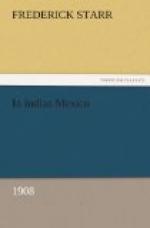took us at once to his house. The town is small,
the population a miserable mixture of black, white,
and indian elements. Few of the couples living
there have been legally married. The parish is
one of the worst in the whole diocese. The bishop
warned the padre that it was an undesirable field,
but it was the only one then unoccupied. But
the padre was working wonders and the church was then
undergoing repairs and decorations. The actual
curato was long ago seized by the government
and is now used as a schoolhouse. The priest lived
in a rented house close by the river bank. The
house is a double one and the priest occupied but
half of it; those in the other half were hostile to
him and he was anxious to rent the whole place.
His neighbors, however, did not care to leave and
threatened vengeance; they were behind a mass of accusations
filed against him with the bishop. His friends
rallied to his support, sent in a strong endorsement,
and he remained. The padre had been industrious
while here. Behind his house is the little river,
with a bath-house built over it; crossing in a dugout
canoe we found his garden flourishing, filled with
fresh vegetables. The family of pets had grown;
Baldur, Freia, Votan, Doxil—the dogs—were
here as at Chila, but he also had fantail and capuchin
pigeons, hens and chicks, ducks and geese, canary
birds, and native birds in cages. Here also were
archaeological relics, plants, beetles and birds for
gathering. And here too, for the first time,
I had the opportunity of examining his great collection
of Ecuadorean humming-birds and a magnificent lot of
Guatemalan quetzal skins, among them probably the finest
ever collected.
[Illustration: THE PADRE’S HOUSE; MEDELLIN]
[Illustration: THE CHURCH; MEDELLIN]
We left Medellin on January 8th; went by rail to Puebla,
then to Oaxaca. Here we found our friend Doctor
Hyde, of Silao, who was nursing Lucius Smith, in what
proved to be a final illness. He aided us in finding
animals and completing preparations for our journey.
We secured a large bay horse for myself, a roan for
Ernst, a little mule for baggage. For my own
part, I dislike mules; Ernst and the doctor, however,
were loud in their praise of such a beast; both asserted
that a good mule should sell for double its cost on
our arrival at Guatemala City. When, finally,
after inspecting a variety of animals we found one
lively, young one, the doctor was delighted.
Taking me to one side, he informed me that such an
opportunity was unlikely to occur again. I yielded
and the little mule was ours. We named the three
animals Mixe, Zapotec, and Chontal, from three tribes
through whose country we expected to pass.
The doctor’s helpfulness was not confined to
advice regarding mules. He insisted upon our
buying various supplies, such as boxes of sardines,
sago, coffee, etc., the utility of which appeared
neither at the time nor later. Also at his suggestion
a quart of whiskey was purchased and carefully divided
into two flasks, one for each saddlebag. Most
useful of all the doctor’s suggestions, and
one for which we had reason many times to thank him,
was the securing from the governor of a letter to
all local authorities in the state, directing them
to supply us with the necessities of life, at just
prices.




